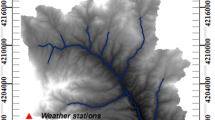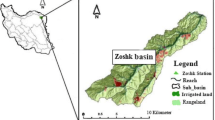Abstract
Uncertainty analysis is crucial before hydrological simulation to address model vulnerability in snow-covered mountainous river basins, ensuring effective soil conservation and water resource management planning. The present study is conducted on Sutlej River Basin, which is located in Western Himalayas and originated from Manasarovar Lake at Tibetans platue in China. The Soil and Water Assessment Tool (SWAT) model is calibrated; the parameter sensitivity and uncertainty of the SWAT were quantified using four optimization methods such as (i) sequential uncertainty fitting (SUFI-2), (ii) particle swarm optimization (PSO), (iii) generalized likelihood uncertainty estimation (GLUE), and (iv) parameter solution (ParaSol). The model is performed with calibration period (1982–2000) and validation period (2001–2013), using monthly observed streamflow at the Bhakra gauging station. The statistical performance criteria such as Nash–Sutcliffe efficiency coefficient (NSE) and coefficient of determination (R2), values showing all four models, performed very well in the model calibration and validation. During the calibration period, SUFI-2 and ParaSol algorithms show higher performance with NSE and R2 values of 0.82 and 0.83. In the validation period, SUFI-2 shows high accuracy with NSE and R2 values of 0.77 and 0.78, while ParaSol also performed well with NSE and R2 values of 0.71 and 0.76. These results highlighted the superior performance of SUFI-2 and ParaSol compared to the other two (PSO, GLUE) techniques. Further, the values of p-factor and r-factor reveal that ParaSol method performed poor during both the calibration period (p-factor: 0.25, r-factor: 0.32) and the validation period (p-factor: 0.26, r-factor: 0.38). These results suggest that while ParaSol was effective in optimizing parameter sets, it fails in providing accurate estimates of uncertainty during both model calibration and validation, whereas other three methods perform very well in the model uncertainty analysis. This study fills a significant research gap by offering guidance on adjusting sensitive parameters, reducing uncertainty in streamflow simulation, and addressing the challenges specific to hydrological modeling in mountainous river basins, which is different from the previous studies conducted in plain river basins.













Similar content being viewed by others
Availability of data and materials
Some or all data, models, or codes generated used during the study are available from the corresponding author request.
References
Abbaspour KC (2011) SWAT-CUP: SWAT calibration and uncertainty programs-a user manual, vol 106. Swiss Federal Institute of Aquatic Science and Technology, Dübendorf
Abbaspour KC, Yang J, Maximov I, Siber R, Bogner K, Mieleitner J, Srinivasan R (2007) Modelling hydrology and water quality in the pre-alpine/alpine Thur watershed using SWAT. J Hydrol 333(2–4):413–430. https://doi.org/10.1016/j.jhydrol.2006.09.014
Arnold JG, Srinivasan R, Muttiah RS, Williams JR (1998) Large area hydrologic modelling and assessment part I: model development 1. JAWRA J Am Water Resour Assoc 34(1):73–89. https://doi.org/10.1111/j.1752-1688.1998.tb05961.x
Beven K (1993) Prophecy, reality and uncertainty in distributed hydrological modelling. Adv Water Resour 16(1):41–51. https://doi.org/10.1016/0309-1708(93)90028-E
Beven K, Binley A (1992) The future of distributed models: model calibration and uncertainty prediction. Hydrol Process 6(3):279–298. https://doi.org/10.1002/hyp.3360060305
Beven K, Freer J (2001) Equifinality, data assimilation, and uncertainty estimation in mechanistic modelling of complex environmental systems using the GLUE methodology. J Hydrol 249(1–4):11–29. https://doi.org/10.1016/S0022-1694(01)00421-8
Blasone RS, Vrugt JA, Madsen H, Rosbjerg D, Robinson BA, Zyvoloski G (2008) Generalized likelihood uncertainty estimation (GLUE) using adaptive Markov Chain Monte Carlo sampling. Adv Water Resour 31(4):630–648. https://doi.org/10.1016/j.advwatres.2007.12.003
Duan Q, Sorooshian S, Gupta V (1992) Effective and efficient global optimization for conceptual rainfall-runoff models. Water Resour Res 28:1015–1031. https://doi.org/10.1029/91WR02985
Li Z, Xu Z, Shao Q, Yang J (2009) Parameter estimation and uncertainty analysis of SWAT model in upper reaches of the Heihe river basin. Hydrol Process Int J 23(19):2744–2753. https://doi.org/10.1002/hyp.7371
Liang Y, Cai Y, Sun L, Wang X, Li C, Liu Q (2021) Sensitivity and uncertainty analysis for streamflow prediction based on multiple optimization algorithms in the Yalong River Basin of southwestern China. J Hydrol 601:126598. https://doi.org/10.1016/j.jhydrol.2021.126598
Moriasi DN, Arnold JG, Van Liew MW, Bingner RL, Harmel RD, Veith TL (2007) Model evaluation guidelines for systematic quantification of accuracy in watershed simulations. Trans ASABE 50(3):885–900. https://doi.org/10.13031/2013.23153
Nash JE, Sutcliffe JV (1970) River flow forecasting through conceptual models part I—A discussion of principles. J Hydrol 10(3):282–290. https://doi.org/10.1016/0022-1694(70)90255-6
Paul M, Negahban-Azar M (2018) Sensitivity and uncertainty analysis for streamflow prediction using multiple optimization algorithms and objective functions: San Joaquin Watershed. California Model Earth Syst Environ 4(4):1509–1525. https://doi.org/10.1007/s40808-018-0483-4
Price K, Purucker ST, Kraemer SR, Babendreier JE, Knightes CD (2014) Comparison of radar and gauge precipitation data in watershed models across varying spatial and temporal scales. Hydrol Process 28(9):3505–3520. https://doi.org/10.1002/hyp.9890
Refsgaard JC, Van der Sluijs JP, Brown J, Van der Keur P (2006) A framework for dealing with uncertainty due to model structure error. Adv Water Resour 29(11):1586–1597. https://doi.org/10.1016/j.advwatres.2005.11.013
Servat E, Dezetter A (1991) Selection of calibration objective fonctions in the context of rainfall-ronoff modelling in a Sudanese savannah area. Hydrol Sci J 36(4):307–330
Srinivasan R, Ramanarayanan TS, Arnold JG, Bednarz ST (1998) Large area hydrologic modelling and assessment part II: model application 1. JAWRA J Am Water Resour Assoc 34(1):91–101. https://doi.org/10.1111/j.1752-1688.1998.tb05962.x
Tang X, Zhang J, Wang G, Jin J, Liu C, Liu Y, Bao Z (2021) Uncertainty analysis of SWAT modelling in the lancang river basin using four different algorithms. Water 13(3):341. https://doi.org/10.3390/w13030341
vander Keur P, Refsgaard J, van der Sluijs J, Brown J (2004) A framework for dealing with uncertainty due to model structure error. In: AGU fall meeting abstracts, vol 2004, pp H14A-05. https://doi.org/10.1016/j.advwatres.2005.11.013
Wang LP, Ochoa-Rodriguez S, Onof C, Willems P (2015) Singularity-sensitive gauge-based radar rainfall adjustment methods for urban hydrological applications. Hydrol Earth Syst Sci 19(9):4001–4021. https://doi.org/10.5194/hess-19-4001-2015
Wu H, Chen B (2015) Evaluating uncertainty estimates in distributed hydrological modelling for the Wenjing River watershed in China by GLUE, SUFI-2, and ParaSol methods. Ecol Eng 76:110–121. https://doi.org/10.1016/j.ecoleng.2014.05.014
Wyss J, Williams ER, Bras RL (1990) Hydrologic modelling of New England river basins using radar rainfall data. J Geophys Res Atmos 95(D3):2143–2152. https://doi.org/10.1029/JD095iD03p02143
Xue C, Chen B, Wu H (2014) Parameter uncertainty analysis of surface flow and sediment yield in the Huolin Basin. China J Hydrol Eng 19(6):1224–1236. https://doi.org/10.1061/(ASCE)HE.1943-5584.0000909
Yang J, Reichert P, Abbaspour KC, Xia J, Yang H (2008) Comparing uncertainty analysis techniques for a SWAT application to the Chaohe Basin in China. J Hydrol 358(1–2):1–23. https://doi.org/10.1016/j.jhydrol.2008.05.012
Yang T, Wang X, Yu Z, Krysanova V, Chen X, Schwartz FW, Sudicky EA (2014) Climate change and probabilistic scenario of streamflow extremes in an alpine region. J Geophys Res Atmos 119(14):8535–8551. https://doi.org/10.1002/2014JD021824
Yen H, Wang X, Fontane DG, Harmel RD, Arabi M (2014) A framework for the propagation of uncertainty contributed by parameterization, input data, model structure, and calibration/validation data in watershed modelling. Environ Model Softw 54:211–221. https://doi.org/10.1016/j.envsoft.2014.01.004
Zhang X, Srinivasan R, Bosch D (2009) Calibration and uncertainty analysis of the SWAT model using Genetic Algorithms and Bayesian Model Averaging. J Hydrol 374(3–4):307–317. https://doi.org/10.1016/j.jhydrol.2009.06.023
Zhang J, Li Q, Guo B, Gong H (2015) The comparative study of multi-site uncertainty evaluation method based on SWAT model. Hydrol Process 29(13):2994–3009. https://doi.org/10.1002/hyp.10380
Zhao F, Wu Y, Qiu L, Sun Y, Sun L, Li Q, Wang G (2018a) Parameter uncertainty analysis of the SWAT model in a mountain-loess transitional watershed on the Chinese Loess Plateau. Water 10(6):690. https://doi.org/10.3390/w10060690
Zhao F, Wu Y, Qiu L, Sivakumar B, Zhang F, Sun Y, Voinov A (2018b) Spatiotemporal features of the hydro-biogeochemical cycles in a typical loess gully watershed. Ecol Ind 91:542–554. https://doi.org/10.1016/j.ecolind.2018.04.027
Funding
No funding was received for conducting this study.
Author information
Authors and Affiliations
Contributions
It is confirmed that both the authors have explicitly given consent to submit the work, and each author listed has made substantial contributions to the submitted work.
Corresponding author
Ethics declarations
Conflict of interest
No potential conflict of interest in the subject matters discussed in this manuscript.
Additional information
Edited by Dr. Khabat Khosravi (ASSOCIATE EDITOR) / Prof. Jochen Aberle (CO-EDITOR-IN-CHIEF).
Rights and permissions
Springer Nature or its licensor (e.g. a society or other partner) holds exclusive rights to this article under a publishing agreement with the author(s) or other rightsholder(s); author self-archiving of the accepted manuscript version of this article is solely governed by the terms of such publishing agreement and applicable law.
About this article
Cite this article
Gogineni, A., Chintalacheruvu, M.R. Hydrological modeling and uncertainty analysis for a snow-covered mountainous river basin. Acta Geophys. 72, 3529–3545 (2024). https://doi.org/10.1007/s11600-023-01270-7
Received:
Accepted:
Published:
Issue Date:
DOI: https://doi.org/10.1007/s11600-023-01270-7




